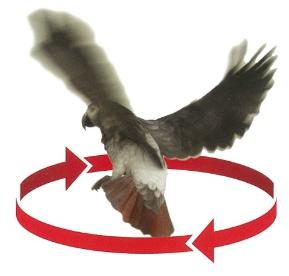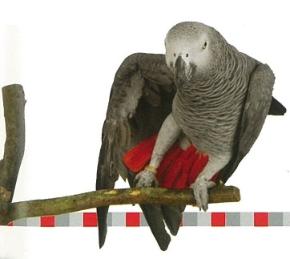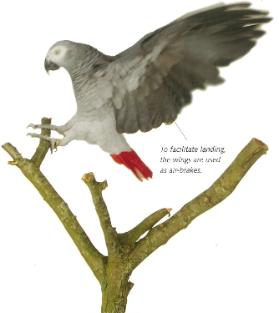Greys are essentially flying creatures and they have evolved over millions of years to perfect their flying abilities. Flying for parrots is as natural as walking is for us. Flying birds never carry any 'excess baggage'. Practically every cell in their body is modified to reduce weight while retaining strength. They have very light hollow bones, very light feathers and carry little or no fat. They also have a powerful 'engine'; the massive pectoral muscles and large heart that enables flight to be sustained for hours if necessary. It is the curved shape of the bird's wings which generate lift. As air flows over them, it results in the wings (and therefore the bird) being pushed upwards. The faster the air flows over the wing, the greater the amount of lift. The outer half of the bird's wing, the primary feathers, provide the propulsion needed to ensure this airflow is maintained. As the bird flaps downwards and backwards, air is pushed backwards over the wings. In addition to gravity, the main limiting factor in flight is the friction between the bird and the air, called 'drag'. However, the bird's streamlined shape minimises drag.
High speed flyers
There are several forms of flight. In powered flight, the wings beat regularly and the bird is able to climb easily and rapidly in the air. Greys fly at about 65kph (40mph) and can cover huge distances even if airborne for only a few minutes. This form of flapping flight is expensive in terms of energy use, but the bird's whole body is very well adapted to the needs of flying. Greys also fly by gliding. Here, the bird does not flap, but keeps its wings held out as it moves forward. Since gliding is 'passive' it results in a loss of height as the bird moves forward. Eventually it either has to land, or switch its 'engine' on and start flapping flight again to regain height. Greys can also hover, turn 360 degrees without flying forward, and deliberately stall at the point of landing as they put their feet out to grip the perch. The whole of the bird's body and wings are used for each flying task. While the primaries are used in propulsion, they are also used as air-brakes when a reverse thrust action is needed when landing.
This bird is moving forward under powered flight and is half-way through the downstroke.
The main thrust comes from the action of the primary feathers. The air flow over the wing generates lift.
The main thrust comes from the action of the primary feathers. The air flow over the wing generates lift.

This bird is flying at a slow speed and keeps
his tail down to maintain control. Greys are highly
manoeuvrable birds on the wing; they can also
hover and spin around in a full circle.
his tail down to maintain control. Greys are highly
manoeuvrable birds on the wing; they can also
hover and spin around in a full circle.

When stretching, parrots extend a left and a wing
from the same side of the body at the same time.
The same side of the tail is also stretched as well.
from the same side of the body at the same time.
The same side of the tail is also stretched as well.

To facilitate landing, the wings are
used as air-brakes.
used as air-brakes.